Bragging while female I have found is one of the most challenging aspects of climbing the corporate ladder. The primary reason for this is of course that gender precludes how women are expected to communicate in the workplace and how we’re expected to relate to our accomplishments. Self-advocacy for women is not nearly as simple as speaking up more in team meetings.
In a recent Inc article, the Work of Sheryl Sandberg’s Lean In resurfaced with some new insights about executive presence for corporate women and the manner and what self-advocacy for women can look like.
Self-Advocacy for Women: the Limitations of Lean In
If you are unfamiliar with Sheryl’s work, you will know that there was a time when she was the go-to authority on self-advocacy for women in corporate spaces. But Sandberg quickly fell out of favor when it was noted that her work is written from a specifically privileged lens, seeing as she is both white and extremely wealthy. The tactics that Sandberg employed to move ahead in her career cannot be indiscriminately applied.
 Let’s face it: executive presence for a white, wealthy woman isn’t going to look the same on a Black lower income woman. And for those of us who identify as BIPOC and femme, the work of such thought leaders as Minda Harts and Elizabeth Leiba, are often more readily applicable to navigating the nuance of self-promotion when multiple intersections of one’s identity put you at a disadvantage.
Let’s face it: executive presence for a white, wealthy woman isn’t going to look the same on a Black lower income woman. And for those of us who identify as BIPOC and femme, the work of such thought leaders as Minda Harts and Elizabeth Leiba, are often more readily applicable to navigating the nuance of self-promotion when multiple intersections of one’s identity put you at a disadvantage.
One thing that has been noticed and that the article highlights is that women’s advocacy efforts and vocal self-adoration is often better received by their male peers when it also includes rationale for how their success will impact the whole. Women’s executive presence is often measured by how their actions impact the community (not just themselves).
The Double-Edged Sword of Assertiveness for Women
A study conducted by George Mason University and Wharton found that when women are more assertive, they are met with negative stereotyping. Whereas men who behave similarly receive praise for the same behaviors. This is a phenomenon already well documented by the work of folks like Susan Cain in her TED Talk and book about the nuance of executive presence, The Power of Introverts.
Tone-Policing Dilemma
When it comes to the prevailing tropes, leaders in corporate roles are loud, gregarious, and extroverted. They are also disproportionately white and male. (Though, the recent Women in the Workplace study does cite double digit gains in more diverse executive leaders in the last 2 years).
The key takeaway in the study is that when women desire to vocalize their achievements they are better received when also highlighting the accomplishments of their peers. Now is this tone policing or a strategy to beat the corporate machine at its own game? Self-advocacy for women becomes a careful dance between authenticity and playing “the game”. When does conscious personal branding bleed over into participating in patriarchy and white supremacy?
The Power of Communal Bragging
In truth, a deeper look into the study demonstrates that all people who take a communal approach to bragging are more likely to be promoted. This falls into a key proponent of public speaking and executive presence best practices. When you want to persuade your audience to do something, you have to be able to communicate the WIIFM (what’s in it for me). And this internal motivation to be swayed is going to change from audience to audience.
 Most notably, self-advocacy for women in American corporate spaces, is about remembering that how you persuade will also be based on the cultural preferences and expectations of your audience. The more you know about your audience, the easier it is to build a compelling case for your ideas.
Most notably, self-advocacy for women in American corporate spaces, is about remembering that how you persuade will also be based on the cultural preferences and expectations of your audience. The more you know about your audience, the easier it is to build a compelling case for your ideas.
Cultural Sensitivity: The Missing Link in Advocacy
In High Tides Facilitator’s Certification program, one of the frameworks we examine is Hofstede’s 6 dimensions of national culture:
- Power distance (high or low index)
- Individualism vs collectivism
- Masculinity vs femininity
- Uncertainty avoidance (high or low index)
- Long vs short term orientation
- Indulgence vs restraint
When thinking about self-advocacy for women (or for anyone), it always comes down to the culture of the conversation that they’re in. We all exist within a cultural context and if we want to truly leverage executive presence, it requires us to think about the biases and stereotypes (grounded in cultural expectations) of our audience. You don’t have to change who you are, but you do have to change your delivery. The key is to stay true to you, even as you learn to speak the language of your audience. So how do you do that?
Four Strategies for Cross-Cultural Self-Advocacy for Women
Here are four strategies for navigating advocacy in different cultural contexts.
Collectivist Cultures (e.g., Japan, China): In these settings, boasting about individual achievements could be seen as selfish or disruptive to group harmony. Women could frame their achievements as a contribution to the collective goals or values of the organization, thus highlighting their role within the larger context.
High Uncertainty Avoidance Cultures (e.g., Greece, Portugal): In cultures where there is less tolerance for ambiguity and risk, women could focus on presenting their achievements as solutions to problems or ways to mitigate risks, thus showing their value in bringing stability.
High Power Distance Cultures (e.g., India, Malaysia): In these cultures, authority is respected and hierarchies are important. Women can leverage this by aligning their achievements with the objectives of higher-ups, showing that their work directly contributes to overarching company goals.
Feminine vs Masculine Cultures (e.g., Sweden vs the United States): In feminine cultures, where equality and quality of life are emphasized, women can showcase how their work-life balance contributes to a happier, more productive work environment. In more masculine-driven cultures, highlighting competitiveness or how they’ve outperformed benchmarks could resonate more.
Notice that while American cultural norms are drawn to those that can speak to their measurable outcomes, the expected gender expression tropes in the US, make it difficult for women to embody this ideal. Women are expected to be more “feminine” which in Hofstede’s definition relates to being more consensus oriented and driven by overall quality of life. In contrast, male leaders are applauded for hitting their targets, and demonstrations of prowess over their counterparts.
Self-Advocacy for Women: The Big Picture
 The takeaway: women in the American workplace are better able to promote themselves when they can also demonstrate the impact of their successes on holistic wellbeing (the team, the organization, the community) at large. Self-advocacy for women then becomes an exercise in zooming out from what you want, and being able to articulate the larger impact you can create when you are promoted and elevated to positions of higher authority. When you communicate the win-win everyone benefits.
The takeaway: women in the American workplace are better able to promote themselves when they can also demonstrate the impact of their successes on holistic wellbeing (the team, the organization, the community) at large. Self-advocacy for women then becomes an exercise in zooming out from what you want, and being able to articulate the larger impact you can create when you are promoted and elevated to positions of higher authority. When you communicate the win-win everyone benefits.
Curious about how you can advocate for yourself at work? Learn more about our Career Advocate workshop and keynote talks in our service catalog.









